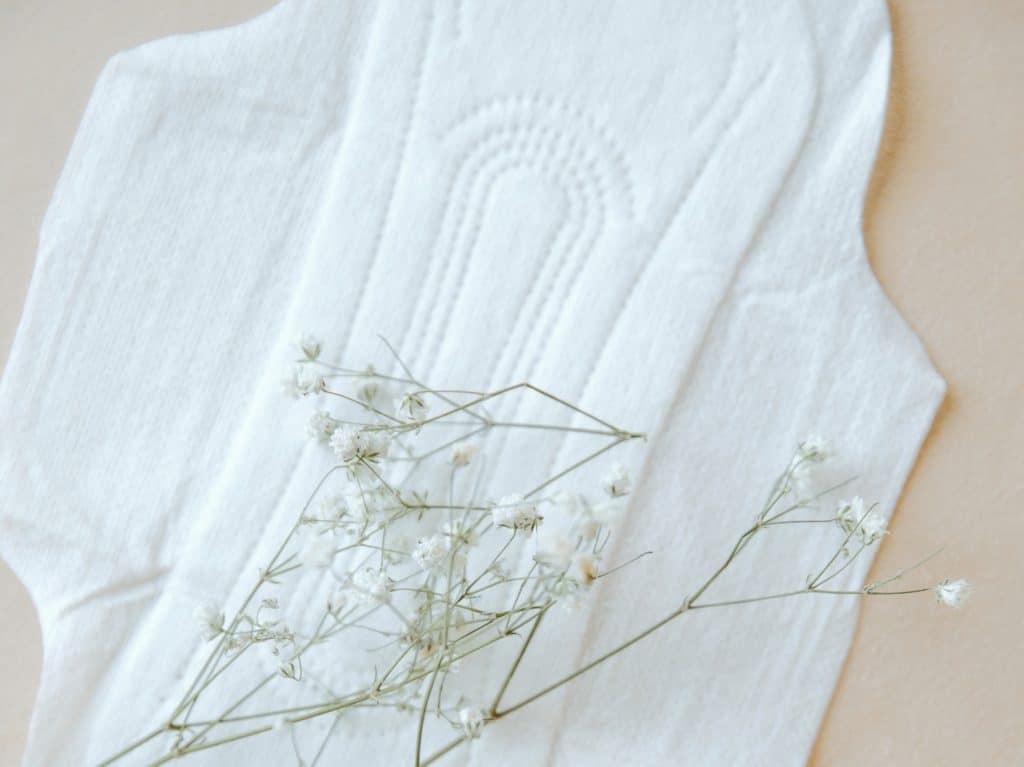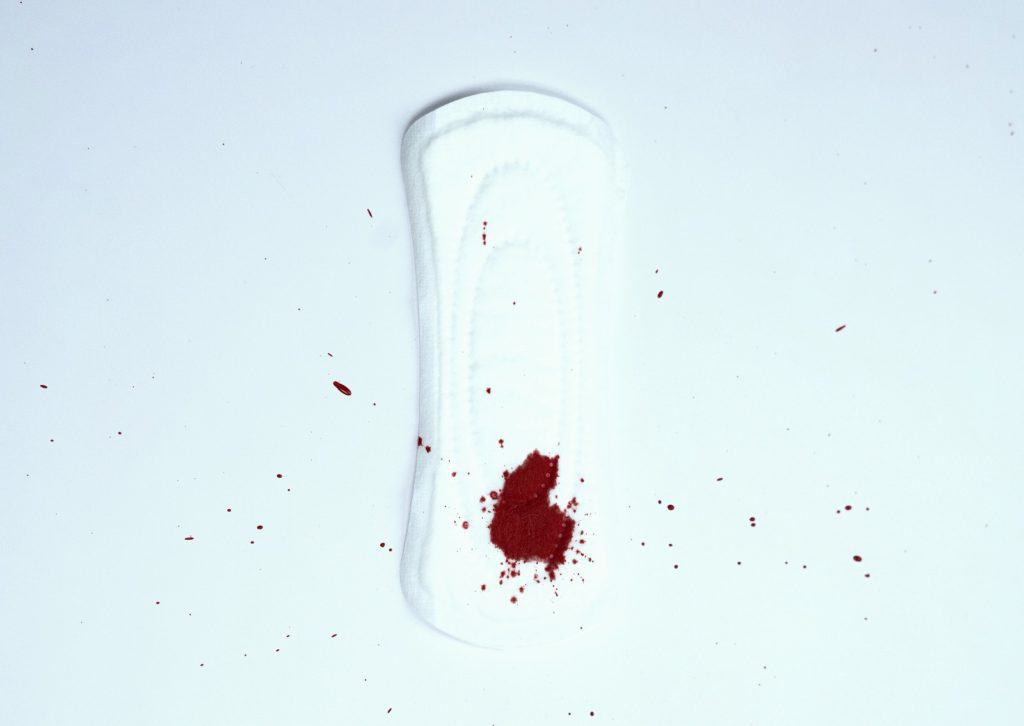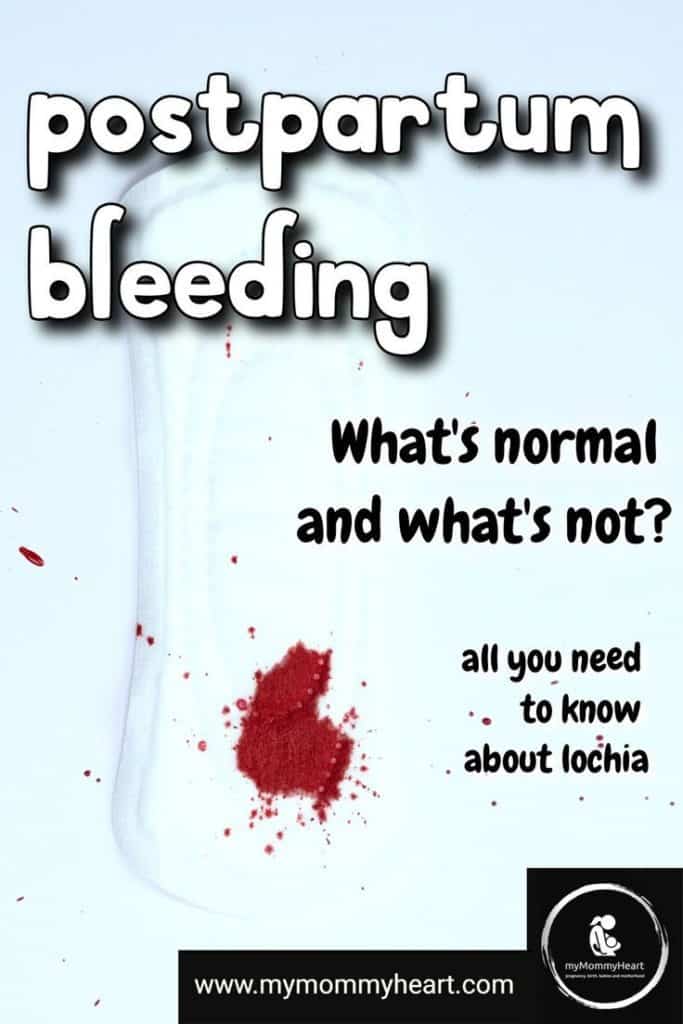
Experiencing postpartum bleeding as a new mom
Are you an expecting or new mom wondering about postpartum bleeding? Why are women bleeding after birth? What’s normal and what’s not? How long will it last? What color should it be like? Can postpartum bleeding stop and start again?
Let’s have a look at what happens in your body after giving birth. If you inform yourself well and know what to expect, it will help you to stay safe. It will guide you to make your postpartum experience as positive as possible despite all the big changes going on.
Disclosure: Please note that this post is NOT intended to take place of medical care or professional advice. Seek help from a health care provider if you need it!

Disclosure: MyMommyHeart is a participant in the Amazon Services LLC Associates Program, an affiliate advertising program designed to provide a means for sites to earn advertising fees by advertising and linking to amazon.com
What to expect after giving birth
Per definition, the so-called postpartum period lasts from the birth of the placenta up to approximately 6 weeks after delivery. During that time, your body, your emotions, and your relationship with your child and partner go through enormous changes.
Physical and emotional postpartum changes
The body produces different hormones during the postpartum period than during your time of being pregnant.
After birth, your hormones now influence your feelings towards your baby. They also make your breast milk come in and initiate uterine regression.
Within 6 weeks, your uterus regresses from a weight of approx. 1.5 kg at the end of pregnancy to the size of a fist with a weight of around 50 – 70 g.
It happens through more contractions caused by the hormone oxytocin, mainly when breastfeeding. Those contractions are not felt equally by all women but usually increase in pain level with each added childbirth.
These body changes happen to every woman, regardless of having had a natural delivery or a cesarean delivery.
The flow of postpartum bleeding changes in the first 3-4 weeks from heavy period-like bleeding with fresh blood to yellowish discharge at the end.
Due to the newly gained space in your stomach, your digestion needs a few days to get going again.
It is important to move around a little bit and to drink a lot of water. Increased sweating during the postpartum period is normal and also caused by hormonal changes.
Wow, that is a lot going on in your body in a short amount of time! All these hormonal changes can lead to a rollercoaster of emotions. It is not surprising if you don’t feel quite like yourself within the first couple of weeks after birth.
Besides all your own physical changes during this season, your baby learns to drink from your breast, and the digestion gets going. Also, he or she gets to know you as parents and their whole new world all around.
You too, need time to get to know your child and to become familiar with all the new tasks as a mommy. It is important to give yourself time and grace during the postpartum period.
Postpartum transition and adaption process
Officially, the medically defined postpartum period ends around 6 weeks after having given birth. But this does not mean that your body and emotions will already all be in a new balance.
It can easily take at least 9-12 months until you, as a new family, will be a well-rehearsed team again. The new everyday life takes time to develop.
The time after birth also comes with a new body image. Many women describe an unfamiliar and insecure feeling about their own bodies. And a lack of muscular support due to the loosened pelvic floor and abdominal muscles.
The child is no longer in the womb, and yet the signs of pregnancy have not completely disappeared. For many women, it takes time until they don’t look pregnant anymore after having given birth.
Remember, even the uterus doesn’t just shrink back all the way on day one. Don’t be discouraged with the extra kilos remaining. Your body has gained them over a span of 9 months. Try to give it at least another 9 months to lose it again.
If I can give you one piece of advice as a fellow mommy who has gone through postpartum periods, it would be: Give yourself time and grace! For everything.
Even though birth is a very natural thing, it will take some time to process, heal and adapt to your new family situation.
If you feel completely overwhelmed and not like yourself anymore and these feelings last longer than just the common baby blues, then get professional help. It could be that you are suffering from postpartum depression symptoms. Read more about that here.
But now let’s look closer at one important aspect of this postpartum period.
Postpartum bleeding

Why does postpartum bleeding happen?
It is normal and necessary for a woman to experience postpartum bleeding after having given birth. Regardless of whether she had a natural birth or a cesarean section. The detachment of the placenta creates an open wound within the uterus.
Other words for postpartum bleeding are lochia and postnatal discharge.
By the way, in the immediate postpartum period, some bleeding can also be caused by perineal tears, cuts or bruises down there.
How long does postpartum bleeding last?
The wound left from the placenta takes up to six weeks to heal and be fully closed again. The postpartum period, therefore, needs to be a time of regeneration and physical rest for a mother. The regression of the uterus and the wound healing processes will progress best with rest.
Light postnatal gymnastics and targeted pelvic floor training, of course, are allowed. They support physical regeneration after delivery.
Can postpartum bleeding stop and start again?
Postpartum bleeding can stop and start again. Normally, the flow is not constant. There will be days when you bleed more and days when you bleed less. Especially around two to three weeks after delivery, you will notice a strong overall decrease in the blood flow.
It’s also normal to sometimes feel a gush of blood when standing up or starting to walk. When you move around, your body might let out what was collected when you were laying down or sitting still.
However, your postpartum bleeding shouldn’t stop for long and then start again. It should consistently become less and less over the weeks and slowly change its color. If suddenly you experience fresh, heavy bleeding again after it had decreased already over a couple of weeks, contact your midwife or doctor.
What color should postpartum bleeding be?
Lochia consists of blood, wound secretion, mucus, and tissue remnants from the placenta. Due to the contained blood, it initially has a light red color; as the internal wound heals, it then becomes pink, brownish, and, towards the end of postpartum, yellowish-white.
How can I support the postnatal healing process?
Even if you have no health problems or postpartum complications, the (light, normal) bleeding is a signal from your body that you need to allow yourself to rest to heal.
What is abnormal postpartum bleeding?
You need medical help, if bleeding during the postpartum period exceeds a certain level.
Here is what to look for:
- Bleeding doesn’t decrease after about two weeks, you are still experiencing a heavy flow, and it still appears bright red-colored. This most likely means that the inner wound from the placenta is not closing properly.
- The bleeding becomes as heavy as in the first hours after delivery. If you bleed through more than one big sanitary pad in an hour, your blood loss is too intense.
- It still (or suddenly again) contains large blood clots again after the first couple of days after birth. In this case, placental fragments may have remained in the uterus. In such a case, the wound in the uterine wall cannot heal and causes this increased bleeding.
- The lochia starts to smell unpleasant. Lochia usually smells bland. Any sign of increased odor can be a sign of uterine infection.
- You feel consistent abdominal pain or get a fever. A pressure-sensitive uterus or a painful lower abdomen often accompanied by fever are also signs of inflammation of the uterus and might require antibiotic therapy.
In any of these cases, immediately contact your midwife or doctor! It is definitely better to be safe than sorry in this healing process. There is a certain risk of death involved with postpartum Haemorrhage.
Can I use tampons for postpartum bleeding?
You must wear sanitary pads while the postpartum bleeding lasts. Do not use tampons as they greatly increase the risk of infection. It is important that your lochia can spontaneously flow out of your body.
Personally, I recommend pads like these. Super absorbent, long in shape and convenient.
My friend, Jada from lactationmamas.com listed The Top 10 Best Postpartum Diapers, Pads, & Underwear. Check it out to see what might fit you best.
Can I take a bath postpartum?
Most obstetricians advise to at least wait two weeks with full baths. Refrain from using perfumed bath additives, bubble baths, and shower gels for a while. You don’t want to irritate the sensitive skin of your genital area.
When can i have sex after giving birth
It is not advised to have sexual intercourse in the postpartum period as long as there is still lochia flowing out. The main concern is that bacteria could be transmitted, and an infection could be the outcome.
Last but not least some tips from a midwife friend
To keep the lochia going, it is advisable to regularly lie on your stomach after breastfeeding. Warm feet are also important and beneficial: Put on wool socks or take a warm foot bath! Besides, you can drink so-called regression teas with the lady’s mantle and shepherd’s purse to encourage the uterus to contract. Abdominal massages are also a good idea. Let your partner or your midwife do it for you to stimulate the lochia.

I hope you found all the information you have been looking for and feel safe for your postpartum journey. All the best!
Are you pregnant and getting ready to give birth soon? Check out this free printable checklist for what to pack in your hospital bag for mom, dad and baby.
Or if you are looking for more resources to prepare for life with baby after birth, read this post about bringing your newborn baby home with lots of tips for the first few weeks.


This is so informative and helpful. Thanks for sharing!
A very helpful post! It’s hard to tell what’s normal and what’s not for first time moms
What a helpful post for any mama that’s currently expecting! Thanks for sharing all this info for us postpartum moms!